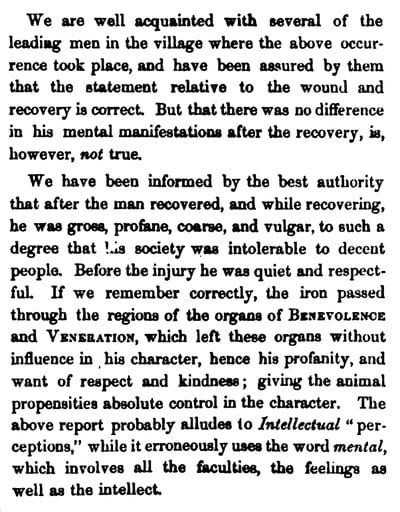Unless you’re a neuroscientist, you’ve probably never heard of Phineas Gage (I hadn’t until a few days ago). He was born in 1823, and he gained a remarkable level of fame during his lifetime. He’s still famous in certain circles – not for having done anything particularly interesting or impressive, but for having something done to him.
Specifically, having a tamping iron (a long, metal rod) fly through his skull during an explosion.
Gage was 25 years old and working for the railroad, planting explosives in order to clear space for new tracks, when one of the charges went off unexpectedly. The metal tool that he used to pack sand around the explosives went through his head, starting at his left cheek and passing through his eye socket before emerging through the top of his skull.
Phineas remarkably survived the incident with all of his mental faculties intact, but even that’s not why his name is still commonly mentioned in neurology circles today. No. Gage’s fame began to spread not because of the ways in which he was the same after the accident, but because of the ways he was different.

Photo Credit: American Phrenological Journal and Repository of Science, Literature, and General Intelligence, Volumes 13-14
According to his physician at the time, Gage’s personality was greatly altered after the iron was removed:
He is fitful, irreverent, indulging at times in the grossest profanity, which was not previously his custom.
Gage’s incident was the first definitive proof that the key to our personalities lay in our physical brains and not in some harder to define realm. Not only that, but because his injuries were to one specific area of the brain, there seemed to be an obvious connection between it and personality.
The fascination with Gage’s case didn’t die out with the people and science of his time. Researchers in the 40s, 80s, and then again in the 90s have all mapped the tamping iron’s trajectory in an attempt to understand just how the objects destructive path affected Gage’s personality.

Photo Credit: Wikimedia Commons
Gage’s case is still relevant today in more ways than one (and for reasons other than morbid fascination, too). For one, people do still sustain serious injuries of this kind. For another, Gage lived a dozen years after his incident and recovered from the personality changes within two to three years. He held a skilled job during that time, as well.
He died when he was 36 from an epileptic seizure that was almost surely related to his injury. His skull is on display at the Warren Anatomical Museum in Boston, MA.
(h/t: NPR)
We know you can choose a lot of sites to read, but we want you to know that we’re thankful you chose Did You Know.
You rock! Thanks for reading!






